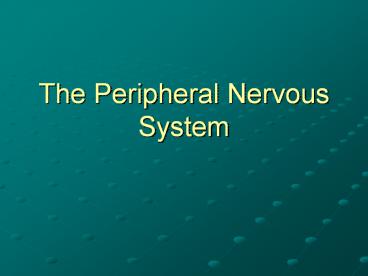The Peripheral Nervous System - PowerPoint PPT Presentation
1 / 25
Title:
The Peripheral Nervous System
Description:
The Peripheral Nervous System – PowerPoint PPT presentation
Number of Views:35
Avg rating:3.0/5.0
Title: The Peripheral Nervous System
1
The Peripheral Nervous System
2
Peripheral Nervous System
- 31 pairs of spinal nerves
- 12 pairs of cranial nerves
- All of the smaller nerves that branch from larger
nerves
3
Afferent and Efferent Pathways
Afferent Pathways
Efferent Pathways
4
Spinal Nerves
- 31 Pairs
- Numbered according to the level of the vertebral
column at which they emerge from the spinal
cavity - Lumbar, Sacral, and Coccygeal nerves descend from
their point of origin at the lower end of the
spinal cord - Lower end of the cord is called the cauda equina,
which means horses tail in Latin
5
(No Transcript)
6
Structure of Spinal Nerves
- Mixed Nerves (contain motor and sensory fibers)
- Attach by means of two short roots
- Dorsal root
- Has ganglion (cell bodies)
- Carries sensory neruons
- Ventral root
- Carries motor neurons
7
(No Transcript)
8
Dorsal and Ventral Rami
- Soon after each spinal nerve emerges from the
spinal cavity, it forms several large branches,
each of which is called a ramus. - Dorsal Ramus
- Supplies somatic motor and sensory fibers to
serveral smaller nerves - Ventral Ramus
- More complex
9
Rami of Spinal Nerves
10
Nerve Plexuses
- Ventral rami of most spinal nerves subdivide to
form complex networks called plexuses. - Cervical plexus
- Brachial plexus
- Lumbar plexus
- Sacral plexus
11
- Damage to one spinal nerve does not mean
complete loss of function in any one region.
12
(No Transcript)
13
Dermatomes and Myotomes
- Each skin surface area supplied by sensory fibers
of a given spinal nerve is called a dermatome. - A myotome is skeletal muscle or group of muscles
that receives motor axons from a given spinal
nerve.
14
Dermatome Distribution of Spinal Nerves
15
Myotomes and Body Movement
16
Cranial Nerves
- 12 pairs
- Connect to the undersurface of the brain
- Pass through small foramina (holes) in the
cranial cavity and skull - Identified by names and numbers
- 3 Types
- Mixed
- Sensory
- Motor
17
(No Transcript)
18
Divisions of the Peripheral Nervous System
19
Somatic Motor Nervous System
- All the voluntary motor pathways outside the CNS
(pathways to skeletal muscles) - Single motor neuron whose axon stretches from the
cell body in the CNS all the way to the effector - Stimulates effectors by means of the
neurotransmitter acetylcholine
20
Somatic Reflexes
- The action that results from a nerve impulse
passing over a reflex arc is called a reflex. - Predictable response to a stimulus
- May or may not be conscious
- Somatic reflexes are contraction of skeletal
muscle - Autonomic reflexes consist of contractions of
smooth or cardiac muscle, or secretion by glands - Used in the diagnosis of disease
21
Knee Jerk Reflex
22
Autonomic Nervous System
- Regulates involuntary effectors
- Major function of the ANS is to regulate
heartbeat, smooth muscle contraction, and
glandular secretion in ways to maintain
homeostasis.
23
Sympathetic and Parasympathetic Divisions
- Sympathetic and Parasympathetic have separate
pathways - Effectors may have dual innervation, that is they
have input from both types of pathways - Parasympathetic rest-and-repair
- Sympathetic fight-or-flight
24
Autonomic Conduction Paths
25
(No Transcript)































